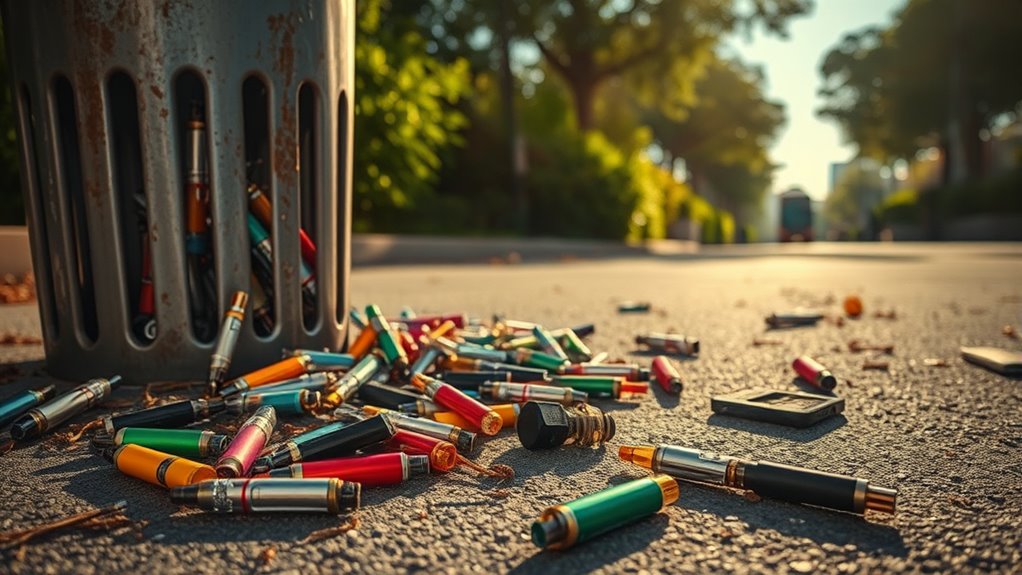Disposable vape pens are a growing environmental concern. Every second, 4.5 devices are thrown away, contributing to massive waste filled with hazardous materials like lithium-ion batteries. Most users don't know how to dispose of them responsibly, putting even more strain on already overwhelmed recycling systems. With only 9.4% of e-waste recycled in the Americas, the pollution and microplastic accumulation is alarming. There's more to uncover about this pressing issue and what you can do to help.
Key Takeaways
- Disposable vape pens generate significant e-waste, with 4.5 devices discarded every second, leading to environmental pollution and microplastic accumulation.
- These devices contain hazardous materials, including lithium-ion batteries, which classify them as toxic waste and pose environmental risks.
- Only 9.4% of e-waste is recycled in the Americas, leaving valuable materials wasted and contributing to landfill overflow.
- Young users are often unaware of proper disposal methods, complicating waste management and increasing environmental impact.
- Manufacturers provide minimal guidance on responsible disposal, shifting the burden onto consumers and highlighting the need for better regulations.
The Growing Problem of Vape Waste

The alarming rise in vape waste is a pressing issue that affects us all. Every second, about 4.5 disposable e-cigarette devices are discarded, leading to staggering annual waste. This waste can stretch over 7,000 miles if lined up end-to-end.
Most of these devices, containing lithium-ion batteries and hazardous materials, are classified as both e-waste and hazardous waste. Unfortunately, only 9.4% of e-waste gets recycled in the Americas, with many young users tossing their devices in regular trash. This contributes to long-term pollution and microplastic accumulation in our environment.
The environmental costs of disposable vapes far exceed those of refillable models, underscoring the urgent need for effective recycling solutions to protect public health and our planet.
Environmental Risks of Disposable Vapes

Many people underestimate the environmental risks posed by disposable vapes, yet their impact is profound. Each second, around 4.5 disposable vapes are discarded in the U.S., contributing considerably to environmental pollution.
Disposable vapes pose significant environmental risks, with 4.5 discarded every second in the U.S., exacerbating pollution.
These devices are non-biodegradable and break down into microplastics, threatening marine life. Their lithium-ion batteries and heavy metals classify them as hazardous waste, complicating recycling efforts.
Here are key environmental risks associated with disposable vapes:
- They generate substantial e-waste that often ends up in landfills.
- The toxic substances released can lead to environmental degradation.
- Only 9.4% of e-waste in the Americas is recycled, leaving valuable materials wasted.
Addressing these issues is essential for a healthier planet.
Challenges in Recycling E-Cigarettes

While the rise of e-cigarettes has transformed smoking habits, recycling these devices presents significant challenges. Many users don't know the proper disposal methods for e-cigarette waste, leading to improper disposal in regular trash or curbside recycling.
The complex design of vape pens incorporates mixed materials and hazardous materials, making it difficult to recycle e-cigarettes effectively. Most recycling facilities aren't equipped to handle components like lithium-ion batteries and residual nicotine, which pose risks to environmental health.
Without standardized legal recycling methods in the U.S., many devices end up in landfills, contributing to plastic waste. E-cigarette manufacturers often provide little guidance on responsible disposal, leaving consumers unaware of the environmental impact of their actions.
Young Users' Awareness of Vape Waste

Despite the growing popularity of vape pens among young users, awareness of proper disposal methods remains alarmingly low.
Nearly half of young adults using e-cigarettes don't know how to dispose of these devices correctly. Many mistakenly toss their vape waste in regular trash or recycling bins, contributing to environmental harm.
Here's what you should know:
- 49.1% lack knowledge on disposal methods
- 73.7% find it hard to locate drop-off sites
- 46.9% say manufacturers provide minimal information
This knowledge gap about the toxic substances in e-cigarettes further complicates waste management efforts.
It's essential for young users to understand the environmental impact of their actions and seek responsible disposal practices to mitigate harm.
Manufacturer Responsibility and Regulations

Although e-cigarette manufacturers play an essential role in the lifecycle of their products, they often provide minimal guidance on responsible disposal methods. This lack of direction leaves you with uncertainty about the proper disposal of vape pens.
Without a standardized way to recycle e-cigarettes, you're likely contributing to environmental consequences, as improper waste management poses an environmental threat. E-cigarette manufacturers should take on more manufacturer responsibility by advocating for a legal way to recycle their products.
The Centers for Disease Control emphasizes the need for environmentally responsible practices, but manufacturers generally shift the disposal burden onto consumers. It's vital for the tobacco industry to acknowledge its role in this issue and promote standardized disposal processes to mitigate ecological impacts effectively.
The Need for Industry Accountability

It's essential for e-cigarette manufacturers to take responsibility for the disposal of their products.
Without standardized recycling solutions, you're left with little guidance and increasing environmental risks.
Holding the industry accountable can lead to better practices that protect our planet.
Manufacturer Disposal Responsibility
As e-cigarettes become increasingly popular, the lack of manufacturer responsibility for the disposal of these products raises significant environmental concerns.
Most manufacturers provide minimal guidance on proper disposal, leaving you confused about what to do with your used e-cigarette devices and cartridges. This negligence contributes to significant electronic waste and pollution.
- Many disposable vapes sold lack clear disposal information.
- There's no standardized recycling method in the U.S. for these tobacco products.
- Manufacturers fail to acknowledge their role in the environmental impact of nicotine-containing devices.
It's essential for the tobacco industry to recognize its responsibility in e-cigarette waste production and implement clear disposal processes.
This way, you can help mitigate ecological harm while enjoying your products.
Standardized Recycling Solutions
While the popularity of vape pens continues to rise, the urgent need for standardized recycling solutions has never been clearer. Improper disposal of disposable vape pens contributes considerably to environmental hazards. Currently, e-cigarette manufacturers provide minimal guidance, leaving you without clear instructions for waste management. With around 92% of these devices ending up in landfills, it's essential to make manufacturers accountable for the hazardous components involved.
| Challenge | Impact |
|---|---|
| Lack of Standardized Solutions | Increased e-waste and pollution |
| Complex Design | Difficulty in recycling efforts |
| Insufficient Guidelines | Continued environmental hazards |
We need thorough guidelines to effectively address the environmental impact of e-cigarette waste.
Recommendations for Sustainable Practices

To reduce the environmental impact of vape pens, you can start by choosing reusable devices over disposable ones.
Disposable e-cigarettes contribute greatly to plastic pollution and e-waste. Here are some sustainable practices you can adopt:
- Support legislation like California's AB 1690 to ban single-use products.
- Familiarize yourself with local recycling programs for proper disposal of used devices.
- Encourage manufacturers to create recyclable products and provide clear disposal instructions.
Participating in public awareness campaigns can also help educate others about responsible practices.
With 49.1% of young vapers unaware of proper disposal methods, your efforts can make a difference. By making informed choices, you can help mitigate the environmental impact of vaping.
Frequently Asked Questions
What Are the Environmental Issues With Vaping?
When you vape, you're contributing to serious environmental issues.
Disposable vape pens generate massive waste, with millions ending up in landfills every year. These devices contain hazardous materials that can leach into soil and water, harming ecosystems.
Since most users don't recycle their vapes properly, they become non-biodegradable trash, breaking down into microplastics.
Awareness of proper disposal methods is essential if you want to minimize your environmental footprint while enjoying vaping.
What Are 5 Negative Effects From Vaping?
Vaping's got its downsides, and you should know about them.
First, it harms your lungs, causing respiratory issues.
Second, you risk addiction to nicotine, which can lead to withdrawal symptoms.
Third, your indoor air quality suffers, affecting those around you.
Fourth, you might experience mouth and throat irritation.
Finally, the long-term effects on your heart health are concerning.
It's definitely not all clouds and sunshine when it comes to vaping.
Is It Harmful to Vape in the House?
Yes, it's harmful to vape in the house.
When you vape indoors, you release harmful substances like nicotine and heavy metals into the air. These pollutants can linger and affect everyone in the space, especially children and those with respiratory issues.
You mightn't notice the immediate effects, but prolonged exposure can lead to serious health risks.
It's best to step outside to protect both your health and the health of those around you.
How Bad Are Vape Batteries for the Environment?
Vape batteries are like ticking time bombs for the environment.
When you toss them in the trash, they leach toxic metals like lead and cadmium into the soil and water, causing serious pollution.
With only 9.4% of e-waste being recycled, it's clear that improper disposal is a growing issue.
You mightn't realize it, but every battery you discard can contribute to a larger environmental crisis.
Choose safe disposal options to mitigate the damage.
Conclusion
In summary, just like a balloon that floats away and pollutes the sky, vape pens leave behind a trail of environmental harm. As a consumer, you can make a difference by choosing sustainable options and advocating for better regulations. It's essential for manufacturers to step up and take responsibility for their products. By raising awareness and pushing for change, we can help protect the planet while still enjoying the freedoms that come with vaping.










